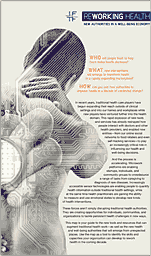Future Now
The IFTF Blog
Reworking Health: Embedding Care Protocol Adherence
Ambient Authority: Embedding Adherence by Enchanting the Mundane
A couple of years ago, I happened upon one of my favorite descriptions for a world where virtually everything we own is networked: The Internet of the Mundane—a term that was used to argue that tools like Nest, a smart thermostat that adjusts in the background to its users climate preferences without asking the user to do anything, represents a huge innovation opportunity. The idea of the Internet of the Mundane is to raise some deceptively simple questions: What would you choose to ignore if you could automate boring minutiae? How would you enlist the stuff of your environments to help you manage your life?
This question is particularly critical in health care—where any split second decision can require remembering thousands of details and variables, and where a mistake can cause problems such as death. In our 2013 research, Reworking Health: New Authorities in a Well-Being Economy, we argued that as the objects of our world get connected, they will turn into simple but critical tools to help us remember the tiny details we need to remember to stay healthy.
In many ways, a device like the Intelligent M bracelet, which reminds its user to wash her hands when entering a hospital room, is both an example of the Internet of the Mundane, but also a signal of what author David Rose calls Enchanted Objects. Rose, who will be keynoting our upcoming conference on Health Aware Environments, describes enchanted objects in terms that are, once again, deceptively simple. They have a little bit of intelligence—but use that intelligence in surprisingly clever ways to act on our behalf, whether it’s reminding a nurse to wash his hands, or a person to take a pill.
But while embedding intelligence into objects is, in certain ways, becoming an increasingly easy technology problem, this experimentation is likely to usher in an explosion of experiments in interface design. In projects from outside of health, for instance, I’ve come across everything from wallets that won’t open if you spend too much money to toothpaste that changes its taste to tell you the weather when you wake up to brush your teeth.
These kinds of designs point to both the challenge and opportunity of a world in which our objects and environments are alive and act on our behalf: A challenge to find intuitive ways to enchant the mundane to improve our health.
In our 2013 Health Horizons research, Reworking Health, we examined four emerging sources of authority—computation, narratives, networks, and ambience—that will fundamentally transform who we trust and what interventions will be available in a rapidly expanding health and well-being marketplace.
This series of blog posts dives into the map's forecasts to reveal new opportunities and help you imagine what skills and capacities you or your organization can develop to rework health in the coming decade:
- Automating Media Therapy
- Amplifying the Positive
- Commoditizing Bodywork
- Optimizing the Care Effect
- Uncovering Empowering Identities
- Coordinating Caring Communities
- Calibrating Pain
- Contextualizing Science in Retail Settings
About IFTF's Health Horizons Program
- Contact Dawn Alva at dalva@iftf.org or 650-233-9585




